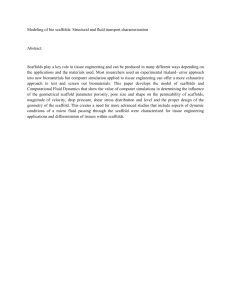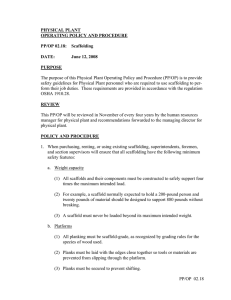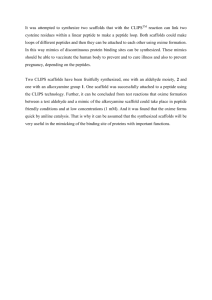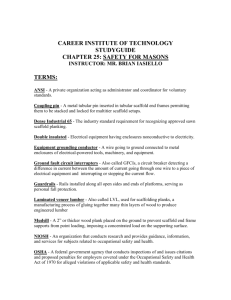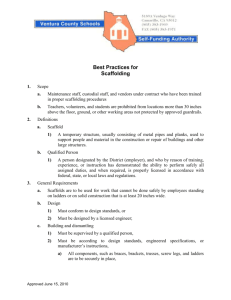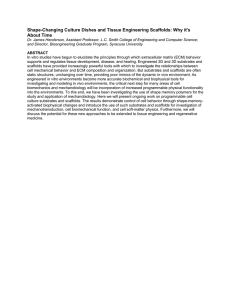OSHA Scaffold Standard for Construction
advertisement
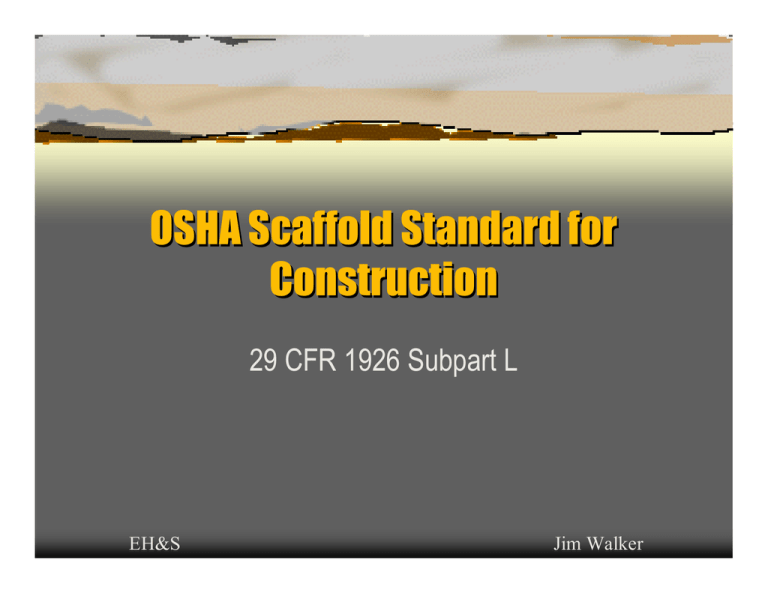
OSHA Scaffold Standard for Construction 29 CFR 1926 Subpart L EH&S Jim Walker What is the revised OSHA scaffold standard for construction?  Issued on August 30, 1996 and became effective on November 29, 1996. Known as “Safety Standards for Scaffolds Used in the Construction Industry. Sets performance based criteria to protect employees from scaffold – related hazards such as falls, falling objects, structural instability, electrocution, or overloading. Why did OSHA revise the standards for scaffolding?  To simplify and update the previous standards – in use since May 1971. OSHA estimates the revised standards prevent about 4,455 injuries and 47 deaths each year, saving employers $90 million annually in lostworkday costs resulting from scaffold related injuries. What do I need to Know and how can I get that information?  All employers and their employees using scaffolds in the construction industry must be familiar with these standards. What do I need to Know and how can I get that information?  The electronic address to view or download a copy of the OSHA standard as found on OSHA’s Website is http://www.osha.gov/. ÂThe regulatory text also is found in 29 CFR 1926, Subpart L, which is available from the Government Printing Office at (202) 512-1800; (202) 512-2250 fax – Order No. S/N 869-038-001071; cost $30.00 Are there other standards that apply to scaffolds?  29 CFR contains other standards that apply to construction work such as the responsibility to initiate and maintain programs 1926.29(b)(1); exposures to dusts and chemicals 1926.33,.55,.59,.62, and .1101; Are there other standards that apply to scaffolds?  Hand and power tools 1926.300 - .307; electrical 1926.300 .449; personal fall arrest systems 1926.502; and ladders 1926.1050 .1060. What are the highlights of the revised scaffolding standard? Employers and employees should be familiar with seven key provisions of the revised scaffolding standard: Seven key provisions of the revised scaffolding standard:  The standard requires fall protection at a 10 foot height above a lower level for employees. 1926.451(g)(1) Seven key provisions of the revised scaffolding standard: Guardrail height – The height of top rail for scaffolds manufactured and placed in service before January 1, 2000 can be between 36 and 45 inches.  After January 1, 2000 – The top rail must be between 38 and 45 inches above the work platform. 1926.451(g)(4)(ii)  Seven key provisions of the revised scaffolding standard:  When the cross point of cross bracing is used as a top rail, it must be between 38 and 48 inches above the work platform. Seven key provisions of the revised scaffolding standard:  Mid-rails must be installed approximately halfway between the top rail and platform surface. When a cross point of cross bracing is used, it must be between 20 and 30 inches above the work platform. 1926.451(g)(4) Seven key provisions of the revised scaffolding standard:  Erecting and Dismantling – After September 2, 1997, when erecting and dismantling supported scaffolds, a competent person must determine the feasibility of providing a safe means of access and fall protection for these operations. 1926.451(e)(9) & (g)(2) Seven key provisions of the revised scaffolding standard:  Training – Employers must train each employee who works on a scaffold on the hazards and the procedures to control the hazards. 1926.454 Seven key provisions of the revised scaffolding standard:  Inspections – Before each work shift and after any occurrence that could affect the structural integrity, a competent person must inspect the scaffold components for visible defects. 1926.451(f)(3) Seven key provisions of the revised scaffolding standard:  Overhand bricklaying – A guardrail or personal fall arrest system on all sides except the side where the work is being done must protect employees doing overhand bricklaying from supported scaffolds. 1926.451(g)(1)(vi) Seven key provisions of the revised scaffolding standard:  The standards for aerial lifts have been relocated from 1926.556 to 1926.453. Review The OSHA Scaffold Standard for construction can be found in:  40 CFR 52.1147  29 CFR 1926.Subpart L  29 CFR 1910.440  The correct answer is: Review The Construction Standard requires fall protection for a height above:  4 feet  6 feet  10 feet  The correct answer is: Review After January 1, 2000 – The top rail for scaffolds must be between ___ and ___ inches above the work platform.  Between 24 and 32 inches  Between 32 and 36 inches  Between 38 and 48 inches  The correct answer is: Review Employers must train each employee who works on a scaffold on the hazards and the procedures to control the hazards.  TRUE or FALSE The correct answer is:  Review A visual inspection must be made by a competent person before each work shift and after any occurrence that could affect the structural integrity of the scaffolding.  TRUE or FALSE  When is a competent person required for scaffolding? OSHA’s scaffolding standard defines a competent person as “one who is capable of identifying existing and predictable hazards in the surroundings or working conditions, which are unsanitary, hazardous to employees, and who has authorization to take prompt corrective measures to eliminate them.” The standard requires a competent person to perform the following duties under these circumstances:  To select and direct ÂTo determine if it is safe for employees who erect, employees to work on or from a dismantle, move, or alter scaffold during storms or high scaffolds. winds and to ensure that a personal fall arrest system or wind screens protect these employees. The standard requires a competent person to perform the following duties under these circumstances:  To train employees involved in erecting, disassembling, moving, operating, repairing, maintaining, or inspecting scaffolds to recognize associated work hazards. ÂTo inspect scaffold components for visible defects before each work shift and after any occurrence which would affect the structural integrity and to authorize prompt corrective actions. The standard requires a competent person to perform the following duties under these circumstances:  To inspect ropes on suspended scaffolds prior to each work shift and after every occurrence which could affect the structural integrity and authorize prompt corrective actions. ÂTo inspect manila or plastic (or other synthetic) rope being used for toprails or midrails. The standard requires a competent person to perform the following duties under these circumstances: ÂFor erectors and For suspension scaffolds - To evaluate direct connections to support the load.  - To evaluate the need to secure two-point and multi-point scaffolds to prevent swaying.  dismantlers – To determine the feasibility and safety of providing fall protection and access. Â- To train erectors and dismantlers to recognize associated work hazards. The standard requires a competent person to perform the following duties under these circumstances:  To determine if a scaffold will be structurally sound when intermixing components from different manufacturers. ÂTo determine if galvanic action has affected the capacity when using components of dissimilar metals. When is a qualified person required for scaffolding? The standard defines a qualified person as “one who by possession of a recognized degree, certificate, or professional standing, or who by extensive knowledge, training, and experience – has successfully demonstrated his/her ability to solve or resolve problems related to the subject matter, the work, or the project.” The qualified person must perform the following duties in these circumstances: To design and load scaffolds in accordance with that design.  To train employees working on the scaffolds to recognize the associated hazards and understand procedures to control or minimize those hazards  ÂTo design the rigging for single–point adjustable suspension scaffolds. ÂTo design platforms on two-point adjustable suspension types that are less than 36 inches wide to prevent instability. The qualified person must perform the following duties in these circumstances:  To make swaged attachments or spliced eyes on wire suspension ropes. ÂTo design scaffold components construction in accordance with the design. When is an engineer required? The standard requires a registered professional engineer to perform the following duties in these circumstances: When is an engineer required? To design the direct connections of masons’ multi-point adjustable suspension scaffolds.  To design scaffolds that are to be moved when employees are on them.  To design pole scaffolds over 60 feet in height.  ÂTo design tube and coupler scaffolds over 125 feet in height. ÂTo design fabricated frame scaffolds over 125 feet in height above their base plates. ÂTo design brackets on fabricated frame scaffolds used to support cantilevered loads in addition to workers. When is an engineer required?  To design outrigger scaffolds and scaffold components. Review  One who is capable of identifying existing and predictable hazards in the surroundings or working conditions, which are unsanitary, hazardous to employees, and who has authorization to take prompt corrective measures to eliminate them is called: ÂAn engineer ÂA mason ÂA competent person ÂThe correct answer is: Review One of the duties of a competent person is to design scaffolds that are to be moved when employees are on them  TRUE or FALSE  The correct answer is:  Review A qualified person is one who by possession of a recognized degree, certificate, or professional standing, or who by extensive knowledge, training, and experience has successfully demonstrated his/her ability to solve or resolve problems related to the subject matter, the work, or the project.  TRUE or FALSE  The correct answer is:  What are the capacity requirements for all scaffolds?  Each scaffold component must support without failure its own weight and at least four times the maximum intended load applied or transmitted to it. 1926.451(a)(1)  A qualified person must design the scaffolds, which are loaded in accordance with that design. 1926.451(f)(1) What are the capacity requirements for all scaffolds?  Scaffolds and scaffold components must not be loaded in excess of their maximum intended loads or rated capacities, whichever is less. 1926.451(f)(1)  Load carrying timber members should be a minimum of 1,500 lb-f/in square construction grade lumber. Appendix A (1)(a) What are scaffold platform construction requirements?  Each platform must be planked and decked as fully as possible with the space between the platform and uprights not more one inch wide. The space must not exceed nine inches when side brackets or odd-shaped structures result in a wider opening between the platform and uprights. 1926.451(b)(1) What are the requirements for scaffold planking? Scaffold planking must be able to support, without failure, its own weight and at least four times the intended load. 1926.451(b)(1)  Tables showing maximum permissible spans, rated load capacity, and nominal thickness are in Appendix A (1)(b) & (c)   Solid sawn wood, fabricated planks, and fabricated platforms may be used as scaffold planks following the recommendations by the manufacturer or a lumber grading association or inspection agency. Appendix A (1)(b) & (c) Are there requirements for work on platforms cluttered with debris?  The standard prohibits work on platforms cluttered with debris. 1926.451(f)(13) How wide does the work area need to be on scaffolding?  Each scaffold platform and walkway must be at least 18 inches wide. When the work area is less than 18 inches wide, guardrails and/or personal fall arrest systems must be used. 1926.451(b)(2) Are guardrails required on all open sides of scaffolding?  The standard requires employers to protect each employee on a scaffold more than 10 feet above a lower level from falling to that lower level. 1926.451(g)(1)  To ensure adequate protection, install guardrails along all open sides and ends before releasing the scaffold for use by employees, other than the erection and dismantling crews. 1926.451(g)(4) Are guardrails required on all open sides of scaffolding? Guardrails are not required, however, when the front end of all platforms are less than 14 inches from the face of the work; 1926.451(b(3)  When outrigger scaffolds are three inches or less from the front edge; 1926.451(b)(3)(I)   When employees are plastering and lathing 18 inches or less from the front edge. 1926.451(b)(3)(ii) What materials are unacceptable for guardrails?  Steel or plastic banding must nor be used as a toprail or a midrail. 1926.451(g)(4)(xiii) What are supported scaffolds? Supported scaffolds are platforms supported by legs, outrigger beams, brackets, poles, uprights, posts, frames, or similar rigid support. 1926.451(b)  The structural members: poles, legs, posts, frames, and uprights must be plumb and braced to prevent swaying and displacement. 1926.451(c)(3)  Do employees working on supported scaffolds need to be trained? All employees must be trained by a qualified person to recognize the hazards associated with the type of scaffold being used and how to control or minimize those hazards.  The training must include fall hazards, falling object hazards, electrical hazards, proper use of the scaffold, and handling of materials. 1926.454(a)  When do supported scaffolds need to be restrained from tipping?  Supported scaffolds with a height to base width ratio of more than 4:1 must be restrained by guying, tying, bracing, or an equivalent means. 1926.451(c )(1) How can one prevent supported scaffolding from tipping? Either the manufacturers’ recommendation or the following placements must be used for guys, ties, and braces: How can one prevent supported scaffolding from tipping?  Install guys, ties, or braces at the closest horizontal member to the 4:1 height and repeat vertically with the top restraint no further than the 4:1 height from the top. Vertically every 20 feet or less for scaffolds less than three feet wide; every 26 feet or less for scaffolds more than three feet wide.  Horizontally at each end; at intervals not to exceed 30 feet from one end. 1926.451(c )(1)  What are the footing and foundation requirements for supported scaffolds?  Supported scaffolds’ poles, legs, posts, frames, and uprights must bear on base plates and mud sills, or other adequate firm foundation. 1926.451(c) (2)(i ) & (ii) Are there requirements for access to scaffolds? Employers must provide access when the scaffold platforms are more than two feet above or below a point of access. 1926.451(e)(1)  Direct access is acceptable when the scaffold is not more than 14 inches horizontally and nor more than 24 inches vertically from the other surfaces. 1926.451(e)(8)  The standard prohibits the use of cross braces as a means of access. 1926.451(e)(1)  Does the standard prohibit any types of scaffolds?  Shore and lean-to scaffolds are strictly prohibited. 1926.451(f)(2)  Employees are prohibited from working on scaffolds covered with snow, ice, or other slippery materials – except to remove these substances. 1926.451(f)(8) What are the clearance distances between scaffolds and power lines?  The standard does not require specific clearance distances. However, it provides a table that list minimum distances determined by voltage. 1926.451(f)(6) Power line clearance / minimum distances from insulated lines Voltage Insulated Lines Minimum distance Alternatives Less than 300 volts 3 feet (0.9m) 300 volts to 50kv 10 feet (3.1m) More than 50kv 10 feet (3.1m) plus 0.4 2 times the length of the inches (1.0cm) for each line insulator, but never less than 10 feet (3.1m) 1kv over 50kv Power line clearance / minimum distances from un-insulated lines Voltage Un-insulated Lines Minimum distance Alternatives Less than 50kv 10 feet (3.1m) 2 times the length of the More than 50kv 10 feet (3.1m) plus 0.4 inches (1.0cm) for each 1kv line insulator, but never less than 10 feet (3.1m) over 50kv What are the fall protection requirements for all scaffolds?  Employers must provide fall protection for each employee on a scaffold more than 10 feet above a lower level. 1926.451(g)(1)  After September 2, 1997, a competent person must determine the feasibility and safety of providing fall protection for employees erecting or dismantling supported scaffolds. 1926.451(g)(2) What is fall protection? Fall protection includes guardrail systems and personal fall arrest systems. What is fall protection? Personal fall arrest systems include harnesses, components such as Dee-rings, and snap hooks, lifelines, and anchorage point. 1926.451(g)(3)  Vertical or horizontal lifelines may be used. 1926.451(g)(3)(ii)-(iv)  Lifelines must be independent of support lines and suspension ropes and not attached to the same anchorage point as the support or suspension ropes. 1926.451(g)(3)(iii) & (iv)  When working from an aerial lift, attach the fall arrest system to the boom or basket. 1926.453(b)(2)(v)  When are both fall arrest and guardrail systems required?  Fall arrest and guardrail systems must be used when working on singleand two-point adjustable scaffolds and selfcontained adjustable scaffolds that are supported by ropes. 1026.451(g)(1) Are there protections in the standards for overhead falling objects? To protect employees from falling hand tools, debris, and other small objects, install toe boards, screens, guardrail systems, debris nets, catch platforms, canopy structures, or barricades. In addition, employees must wear hard hats. 1926.451(h)(1) & (2) & (3) Are there training standards for employees who work on scaffolds?  All employees who work on a scaffold must be trained by a person qualified to recognize the hazards associated with the type of scaffold used and to understand the procedures to control and minimize those hazards. 1926.454(a) Are there training standards for employees who work, erect, dismantle, or inspect scaffolds? Are there training standards?  Yes. A competent person must train all employees who erect, disassemble, move, operate, repair, maintain, or inspect scaffolds. Training must cover the nature of the hazards, the correct procedures for erecting, disassembling, moving, operating, repairing, inspecting, and maintaining the type of scaffold in use. 1926.45(b) Are there training standards?  Other recommended training topics include erection and dismantling, planning, personal protective equipment, access, guys and braces, and parts inspection. Appendix D What are the training requirements for employees working on scaffolds? The standard requires retraining when no employee training has taken place for the worksite changes, scaffold changes, or falling object protection changes;  Or when the employer believes the employee lacks the necessary skill, understanding, or proficiency to work safely. 1926.454(e)  Review Each scaffold component must support without failure its own weight and at least twice the maximum intended load applied or transmitted to it.  TRUE or FALSE  The correct answer is:  Review The standard prohibits work on platforms cluttered with debris.  TRUE or FALSE  The correct answer is:  Review Each scaffold platform and walkway must be at least __ inches wide. When the work area is less than __ inches wide, guardrails and/or personal fall arrest systems must be used.  18  24  36  The correct answer is:  Review In some cases guardrails are not required, however, the standard does require employers to protect each employee on a scaffold more than 10 feet above a lower level from falling to that level.  TRUE or FALSE  The correct answer is:  Review Toe boards, screens, guardrail systems, debris nets, catch platforms, canopy structures, and barricades can be used :  to control access  to protect against fallen objects  to store materials  The correct answer is:  Review When working from an aerial lift, always attach the fall arrest system to the adjacent structure.  TRUE or FALSE  The correct answer is:  The End That’s All Folks
